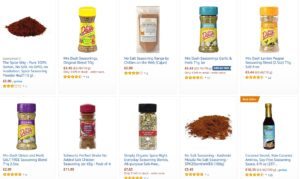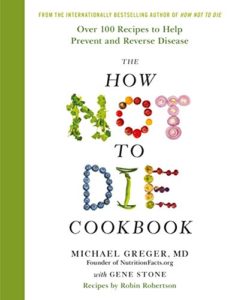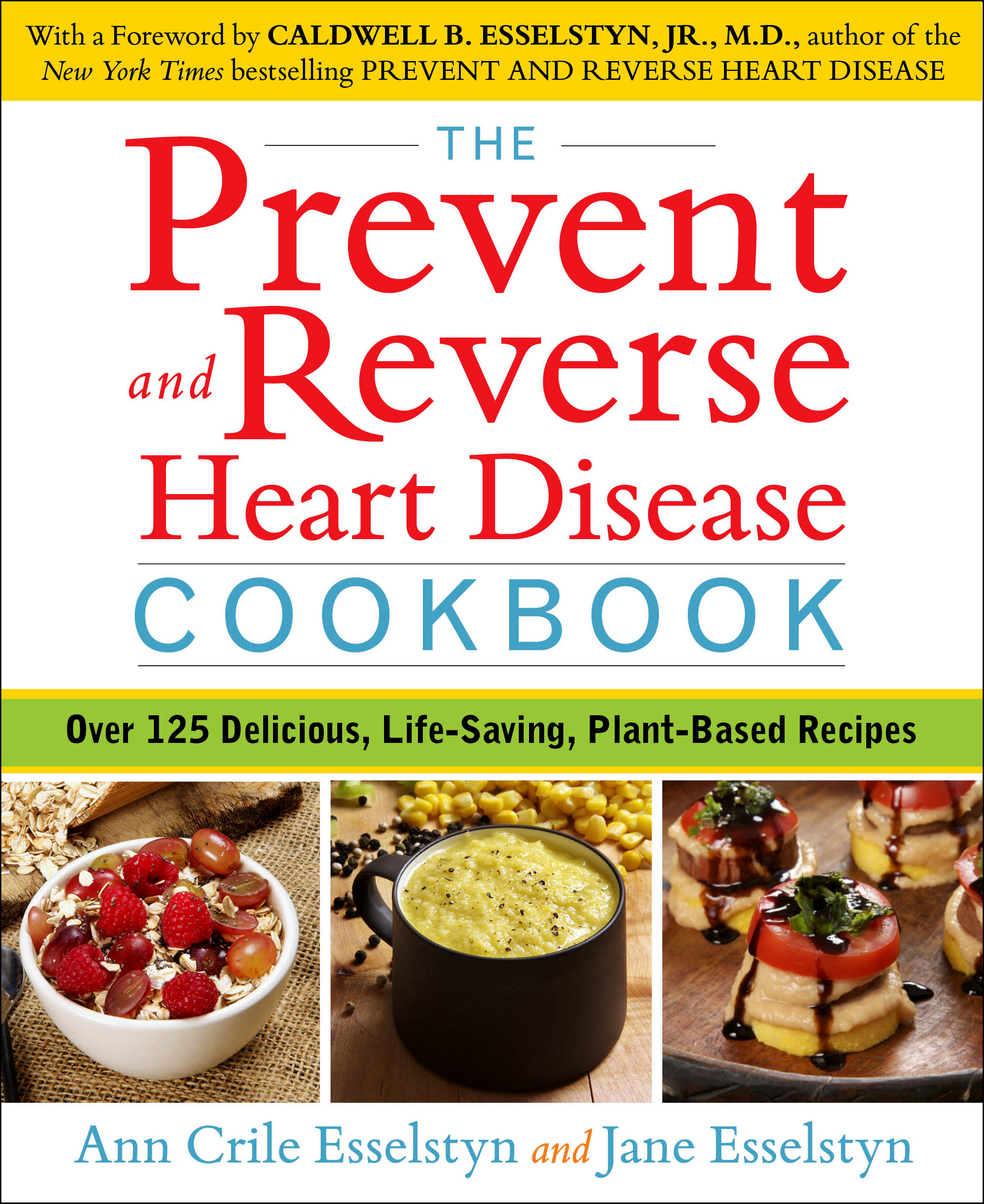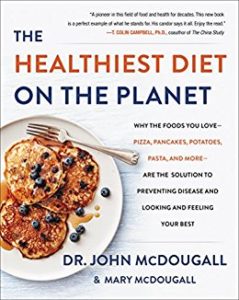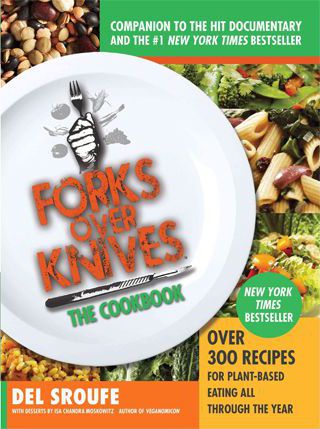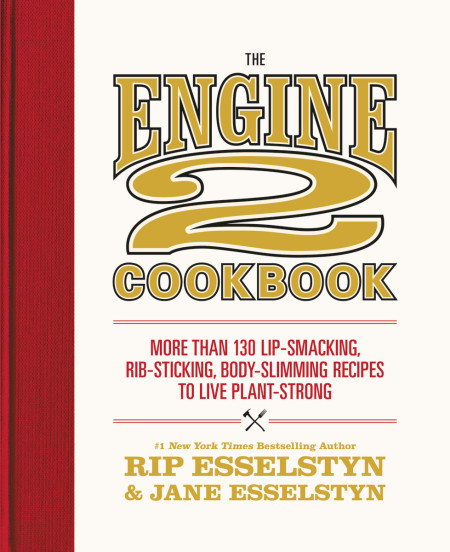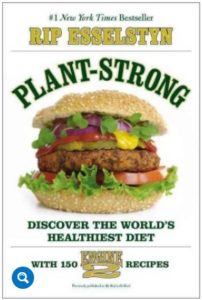
When starting out on your WFPB journey, you may come across some problems with food choices and meal preparation. None of these are insurmountable, but a few handy tips might help you on your way to enjoying the optimal diet for human health.
You will have to excuse me giving some personal advice and examples in this blog. I thought it might be the best way to help.
The three aims of the following tips are to help ensure:
- That you never go hungry or panic about where the next meal is coming from,
- That you prepare snacks and meals really quickly and efficiently, and
- That you eat the most nutritious diet possible – today, tomorrow and every day.
Blog Contents
Tip 1. Microwaves are really useful
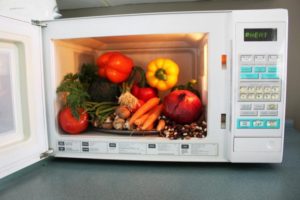
They are also one of the healthiest cooking methods because they preserve so many of the nutrients. And don’t take any notice of the silly scare stories about their dangers. Listen to Dr Greger’s podcast “Are Microwaves Safe?” or look here if you need further convincing.
Just some of the uses to which I regularly put my trusty microwave:
- Baked potatoes – soft-cooked from the microwave, then crisped whole afterwards in the oven, or cut in two and toasted under the grill for a few minutes.
- Reheating meals – stews, soups, pasta meals, etc. Rice needs thorough re-heating and never more than once.
- Cooking or defrosting from frozen – I heat up the frozen berries that I use as a base for my morning muesli. Frozen peas and corn are always being warmed up for one meal or another. Frozen veg and fruit love the microwave!
- Cooking all sorts of veg. Place in a covered microwave container and add only a small amount of water. I use the microwave to cook Brussels sprouts, kale, cauliflower, courgettes (zucchini), onions, the list goes on and on.
- Heating smoothies and drinks of all sorts – each morning I have quarter of a cup of tomato juice that I warm up in the microwave then add 1/4 tsp (teaspoon) turmeric, tsp amla powder, 1 tbsp (tablespoon) ground flax seeds, 1/4 tsp ground black pepper. Stir it up and drink it down. Thanks to Dr Greger for this one.
- Starting off dry ingredients in a little water for curries etc.
- Heating mushrooms for a couple of minutes works really well – add a bit of water, lemon juice or non-salt umami sauce.
These are just a few uses that my microwave gets every day. There are many more imaginative ideas to be found on the internet, for instance here and here (I skip the salt, of course).
Tip 2. Keep the freezer fully stocked

- Every type of berry – shop-bought frozen mixed berries, berries frozen from fresh. I use these for my breakfasts (see below) and also for making Dr Greger’s nice-cream (peeled chopped bananas frozen with frozen berries).
- Lots of veg – peas and corn, greens beans and Brussels sprouts, broccoli and cauliflower, you name it! Some tastes change when frozen, but nutrient values remain high.
- Batches of meals you prepare – useful portion sizes of homemade stews, soups, bakes, curries, etc.
- Homemade bread, flapjacks, brownies, truffles, tortillas, baked goods, veggie burgers.
Tip 3. Make more portions for future use
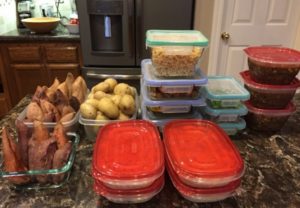
- Whenever you make a meal, always consider making loads more of it so you can either freeze, refrigerate or set portions aside for future meals. (“batch cooking“). When I microwave potatoes and sweet potatoes, I generally throw half a dozen in and then they are ready to quickly heat up or use for future meals.
- Even if you have just a small amount of a meal left over, try to incorporate it as a basis for a future meal. I did this last night with what was left of a bean stew. It found its way into today’s chickpea curry.
Tip 4. Buy and fill lots of containers with dried goods

- Jars, plastic boxes, tins – all chocked full of every spice, herb and dried food you could possibly use. My larder is full of labelled containers with everything from pinto beans, cinnamon and wholewheat pasta to unsulphured apricots, jumbo oats and Dr Greger’s Savoury Spice. The aim is never to run short of anything needed to make a delicious meal.
- Breakfast (or anytime) muesli mix – I keep a huge Tupperware container “locked and loaded” for use first thing in the morning with ready-made muesli mix (after my usual microwaved leafy greens). It contains the following ingredients: jumbo oats and rye, ground flax seed, chia seeds, poppy seeds, pumpkin seeds, sunflower seeds, chopped nuts (walnuts, cashews, pecans, almonds), raisins, chopped dates, unsweetened chopped cranberries, chopped unsulphured apricots, cinnamon powder and unsweetened cocoa powder (the latter two might be an acquired taste for some…). I put a handful of frozen mixed berries into a huge bowl, add a bit of boiling water and/or plant milk, microwave for 2-3 mins, remove, add a couple of handfuls of the muesli mix, chop up a banana, apple and pear (sometimes also a mango or pineapple), then mix it all together. Ready for a snack at anytime during the day.
Tip 5. Keep your refrigerator full of goodness
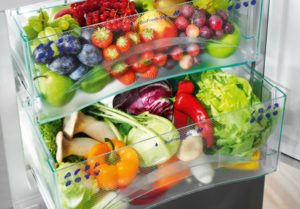
- Some more “sensitive” fresh veg and fruit keep better in the refrigerator – fresh herbs (unless in water), rocket, lettuce, watercress, cucumber, mangetout, mushrooms to name a few. Also, though the skins brown more quickly, bananas last longer when refrigerated.
- Jif squeezy lemon juice. Opened jars of miso, nut butters, etc.
- Opened plant milks and tomato juice.
- Left-overs from previous meals – ready to transform into new delights.
Tip 6. Beans and starchy carbs in profusion
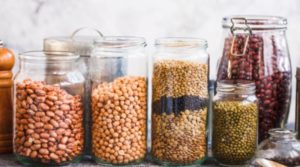
- Every type of uncooked dried bean and pulse that you can find – see here. Soak a variety overnight (check packs for instructions) and they’re ready to cook the next day. Or stick them straight in the pressure cooker (another vital cooking aid).
- Non-salted ready-cooked beans. There are issues (see here and here) with tinned goods (and even issues about Tetra-paks because of aluminium linings), so it’s always better to go to a bit more bother and make your own beans and pulses from dried. However, if you get really stuck for time, I would say eat a tin of baked beans (low salt and sugar, of course) rather than have a panic attack about what you can eat! As an occasional short-cut, it’s better than just rushing out for a Big Mac and fries!
- Buy white, purple and sweet potatoes in large quantities and always have them ready for use.
- Stock up on interesting and varied wholemeal dried pasta, or make your own (without oil or salt) and let me have the recipe/method. Keep lots of wholemeal rice in stock (ideally red or wild rice, and ideally from Thailand or Sri Lanka and not China or California – see here for explanation). And remember, if you are translating this page from English to another language and so cannot easily understand one of Dr Greger’s spoken videos, he always has a transcript below the video frame that you can run through Google Translate.
- Other starchy root veg will store well for a long time and offer huge nutritional value. Think celeriac, butternut squash, beets, swede, turnip, parsnip, mooli, kohlrabi, manioc (cassava), etc. The fact that starchy veg last so long when stored, as our ancestors had to during the barren winter months, will come as no surprise when you consider that we humans are really starchivores, according to Nathaniel Dominy PhD, Dr John McDougall and others.
Tip 7. Alternatives to cooking with oil
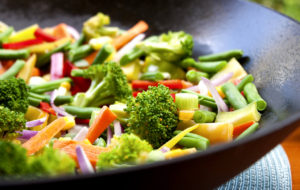
And I mean ANY oil – just leave it out of your meals, your kitchen – your house, if possible. Why? See here, here and even here from the horse’s mouth, if you have any further doubt.
- When frying, use a little water or some veg broth to keep from sticking if necessary, See here and here.
- When oven-roasting, again you can use a little water, veg broth or a tomato juice/spice mix. Here are some ideas.
- Making bread and other baked goods is simple without oil. See here.
Tip 8. Alternatives to cooking with salt
Salt is not something you should be adding to meals. I suggest you simply do not use it – ever.
- See here for some alternative home-made solutions.
- See here for some commercially-available alternatives.
Tip 9. Alternatives to cooking with sugar
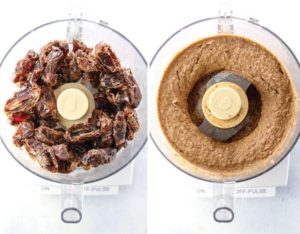
Sugar damages the endothelial cells in your blood vessels, ages your skin, rots your teeth, promotes diabetes and so forth. In any event, it represents empty calories and, with diet being a zero-sum affair, every time you put sugar in your body you are not putting in something else which is healthy and beneficial. In any event, it is best to re-educate your palate to enjoy the natural flavours of food, don’t you think? If in doubt, watch this and read this.
- The healthiest alternative is probably date sugar – not really sugar, just ground up dried dates. I use chopped dates in lots of desserts and breakfasts.
- One way to make wet date sugar. Another way to make dry date sugar is to stick them in a dehydrator (this is the one I use and then blend and grind until they are a powder).
Tip 10. Use nutritional yeast
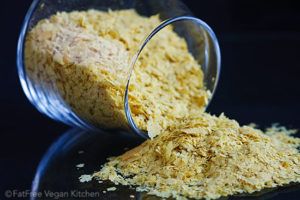
I know this was mentioned in one of the links on Tip 8, but it is such useful stuff that I had to give it pride of place. See here for videos (with transcripts) if you need convincing.
- Some ideas here.
- I use it in soups, stews, on microwaved/steamed/boiled veg, on baked potatoes – pretty much wherever I can.
- Here is where I buy it (12 packs at a time).
- You can buy it with (more expensive) or without B12 fortification. I get enough B12 with my Veg 1 daily supplement, but you can decide if you want fortification based on the amount of B12 you get elsewhere. Here for advice.
- Do not use nutritional yeast if you have Crohn’s disease.
Tip 11. Buy some recipe books – either on Kindle or paper copies
- I tend to get both digital versions (on Kindle) and paper copies (soft/hardbacks).
- The following are some suggestions:
Tip 12. Search the internet for WFPB (no-SOS) recipes and videos
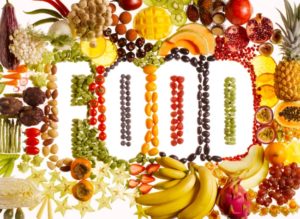
There are lots and lots of wonderful websites with recipes and videos of WFPB non-SOS (no added salt, oil or sugar) meals. Some do have a little salt or sugar in the recipes, and I recommend simply ignoring those ingredients or replacing them with something else (see above).
- I am continually adding recipes here.
- These are some good websites for recipes and meal plans: Forks Over Knives, Oh She Glows, PCRM, Dr McDougall, Nutritionfacts, Ann Esselstyn, Engine2, to name just a few.
- YouTube has hundreds of videos on WFPB no-SOS recipes, whether they cover cooking tips or recipe making.
Tip 13. Plan your meals ahead of time

- Don’t get caught out with a hungry tummy and no idea of what to eat. You can spend one day a week sitting down for an hour or so and write out the whole week’s meal plan. Saves time and allows you to know what ingredients you need and whether you have them in stock or need to buy them.
- There are plenty of websites that give you sample meal plans. Theses are just a few: PCRM, CNS, onegreenplanet, forksover knives, veganopoulous.
Tip 14. Use silicone and non-stick cookware
![]()
- Whether baking bread, muffins or flapjacks, silicone bread tins, muffin trays or baking sheets make life a lot easier when you’re not using oil or fat.
Tip 15. Keep unhealthy choices out of sight and out of reach

- If you really need some sugary or salty “treats”, then realise that they might well be treating your cravings, but your body will always suffer as a result – no matter what the media and your friends might lead you to believe. I have previously explained how research shows it’s a good idea to keep the poor food choices out of sight and out of reach – ideally out of the house!
Tip 16. Experiment and record the results
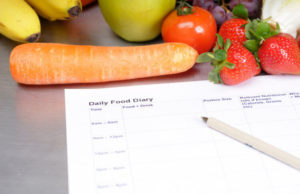
- Try things out. Experiment. Have fun with food.
- When you make something, either from a recipe or not, take a photo of it and write some comments about how well you thought it turned out. I always give new recipes a mark out of 10 – literally writing comments and a score in the recipe book or as a note if on Kindle.
- Keep a food diary. Jot down what you had and how it turned out. Remember that you ARE what you eat, literally. Food is made of oxygen, hydrogen, carbon and nitrogen, with other minerals thrown in for good measure. Your body was made from this stuff when you were in your mother’s womb, and your body is maintained and rebuilt every day with the food that you eat – and nothing else. If a person is not interested in their food, they are probably not interested in the health of their body.
- “Let food be thy medicine and medicine thy food.” Hippocrates.
Tip 17. Maintain a positive attitude

- If you have a positive attitude to preparing your meals and snacks, you’ll avoid the voices in the back of your head that try to tell you that this is all too difficult and you should just do like everyone else and buy the ready meals or phone up the local pizza delivery shop.
Tip 18. Be gentle with yourself
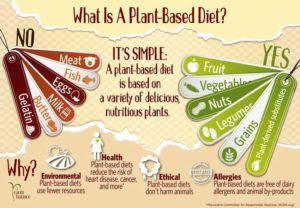
- What you are doing is a truly wonderful thing for your body, for other animal species in general and for our planet as a whole. There may be days when you miss the cheesiness of a pizza or the burnt fattiness of a steak, but that is just a bunch of stubborn pre-programmed neurons that have been badly educated about which sort-cuts you should use to quickly acquire calories. Their effect will diminish with time, just as the smell of a cigarette eventually holds little attraction to an ex-smoker.
- We are all spurred on by finding that clothes fit, acne and skin conditions clear up, hair is smoother, our bodies and breath smell sweeter, blood pressure and pulse rate drop, BMI reduces, energy increases, stomach aches and heart-burn become a thing of the past. But, these are just some of the benefits your dietary and lifestyle changes are making to your body. Much of it is internal and are only revealed when you have blood tests (something I organise for my clients before they make the transition and also at future intervals, as appropriate) – improvements in cholesterol and triglyceride levels, vitamin and mineral profiles, improved functioning of the endothelium, liver, pancreas and kidneys. The list goes on. And all because of what you decide, on a mouthful by mouthful basis, to put into your body.
If there are any other tips that you can think of that I might have missed, please let me know and I will add them for the benefit of others who are about to make the first steps towards a healthier WFPB future.
